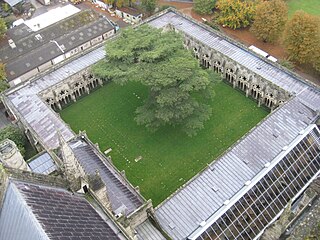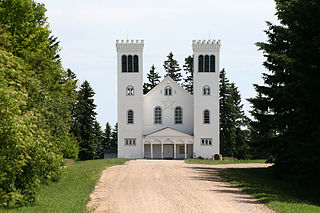Related Research Articles
The Benedictines, officially the Order of Saint Benedict, are a mainly contemplative monastic order of the Catholic Church for men and for women who follow the Rule of Saint Benedict. Initiated in 529 they are the oldest of all the religious orders in the Latin Church. The male religious are also sometimes called the Black Monks, especially in English speaking countries, after the colour of their habits. Not all Benedictines wear black however, with some like the Olivetans wearing white. They were founded by Benedict of Nursia, a 6th-century Italian monk who laid the foundations of Benedictine monasticism through the formulation of his Rule. Benedict's sister, Scholastica, possibly his twin, also became a religious from an early age, but chose to live as a hermit. They retained a close relationship until her death.

A monastery is a building or complex of buildings comprising the domestic quarters and workplaces of monastics, monks or nuns, whether living in communities or alone (hermits). A monastery generally includes a place reserved for prayer which may be a chapel, church, or temple, and may also serve as an oratory, or in the case of communities anything from a single building housing only one senior and two or three junior monks or nuns, to vast complexes and estates housing tens or hundreds. A monastery complex typically comprises a number of buildings which include a church, dormitory, cloister, refectory, library, balneary and infirmary, and outlying granges. Depending on the location, the monastic order and the occupation of its inhabitants, the complex may also include a wide range of buildings that facilitate self-sufficiency and service to the community. These may include a hospice, a school, and a range of agricultural and manufacturing buildings such as a barn, a forge, or a brewery.

A cloister is a covered walk, open gallery, or open arcade running along the walls of buildings and forming a quadrangle or garth. The attachment of a cloister to a cathedral or church, commonly against a warm southern flank, usually indicates that it is part of a monastic foundation, "forming a continuous and solid architectural barrier... that effectively separates the world of the monks from that of the serfs and workmen, whose lives and works went forward outside and around the cloister."

Augustine Baker OSB, also sometimes known as "Austin Baker", was a well-known Benedictine mystic and an ascetic writer. He was one of the earliest members of the English Benedictine Congregation which was newly restored to England after the Reformation.

The English Benedictine Congregation (EBC) is a congregation of autonomous abbatial and prioral monastic communities of Catholic Benedictine monks, nuns, and lay oblates. It is technically the oldest of the nineteen congregations affiliated to the Benedictine Confederation.
St Mary's Abbey, also known as Malling Abbey, is an abbey of Anglican Benedictine nuns located in West Malling, Kent, England. It was founded around 1090 by Gundulf, Bishop of Rochester and dissolved in 1538. The site became a monastery again in the late 19th century.
Dame Werburg Welch, OSB (1894–1990), born Eileen Welch, was an English artist and Benedictine nun. Born in Cheltenham, her father was a Catholic convert, who sent her to convent schools. She studied art at both Southampton and Bristol, before becoming a nun, and continued her art work.

There are a number of Benedictine Anglican religious orders, some of them using the name Order of St. Benedict (OSB). Just like their Roman Catholic counterparts, each abbey/priory/convent is independent of each other. The vows are not made to an order, but to a local incarnation of the order, hence each individual order is free to develop its own character and charism, yet each under a common rule of life after the precepts of St. Benedict. Most of the communities include a confraternity of oblates. The order consists of a number of independent communities.

Stanbrook Abbey is a Catholic contemplative Benedictine Monastery with the status of an abbey, located at Wass, North Yorkshire, England.
Roger Francis Crispian Hollis is the Bishop Emeritus of Portsmouth for the Roman Catholic Church.

St. Peter's Abbey is in Muenster, Saskatchewan, Canada. It is the oldest Benedictine monastery in Canada. It was founded in 1903.
Saint Mary's Abbey in Colwich, Staffordshire was an abbey of Roman Catholic nuns of the English Benedictine Congregation, founded in 1623 at Cambrai, Flanders, in the Spanish Netherlands, and closed down in 2020. During the French Revolution, the community was expelled from France and settled at Mount Pleasant, Colwich, in 1836, where it remained for the next 84 years.

East Bergholt Abbey was an abbey in Suffolk, England. It was built on land purchased in 1857 on the site of Old Hall manor.
Driana Enid Wybourne, professed as Sister Catherine Wybourne OSB, was a British Benedictine nun and prioress of Howton Grove Priory, Hereford. She was also a well-known commentator in the British media, with an internet presence as the Digitalnun.

In This House of Brede is a novel by Rumer Godden published in 1969 by Viking in the US and by Macmillan in the UK.

Catherine Gascoigne was the English abbess of Cambrai from 1624 to 1673.
References
- ↑ Benedictine Yearbook 2011, ed. Rev Dom William Wright, OSB, p.176
- ↑ "Portsmouth R. C. diocese: religious communities". Archived from the original on 2 July 2017. Retrieved 21 January 2011.
- ↑ "Something about Ourselves". www.benedictinenuns.org.uk. Retrieved 30 June 2018.
- ↑ "Media Menu". www.benedictinenuns.org.uk. Retrieved 30 June 2018.
- ↑ "2009 Winners". Christian New Media Awards and Conference. Archived from the original on 21 June 2010. Retrieved 17 September 2022.